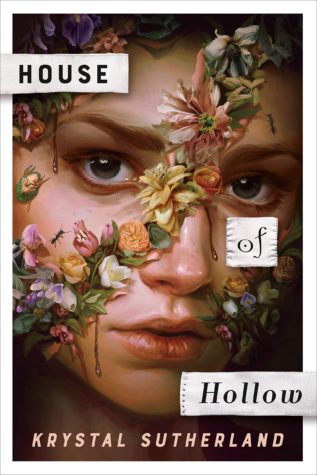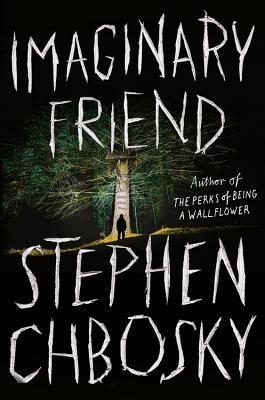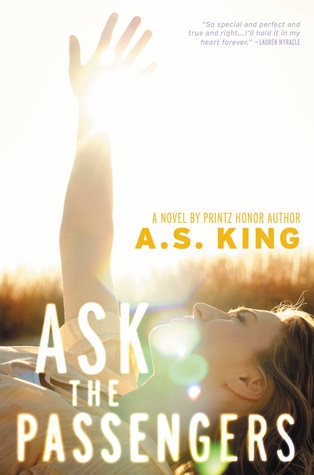
TL;W[on’t]R[read the review]: A shiny, sparkly YA horror-thriller, but the end fizzles out hard.
Content warnings: binge-eating (potential ED triggers), graphic bodily transformation, rot, violence, murder, death of a parent, suicide, death of children (on and off page), threat of sexual assault (brief)
Summary [courtesy of Goodreads]: Seventeen-year-old Iris Hollow has always been strange. Something happened to her and her two older sisters when they were children, something they can’t quite remember but that left each of them with an identical half-moon scar at the base of their throats. Iris has spent most of her teenage years trying to avoid the weirdness that sticks to her like tar. But when her eldest sister, Grey, goes missing under suspicious circumstances, Iris learns just how weird her life can get: horned men start shadowing her, a corpse falls out of her sister’s ceiling, and ugly, impossible memories start to twist their way to the forefront of her mind. As Iris retraces Grey’s last known footsteps and follows the increasingly bizarre trail of breadcrumbs she left behind, it becomes apparent that the only way to save her sister is to decipher the mystery of what happened to them as children. The closer Iris gets to the truth, the closer she comes to understanding that the answer is dark and dangerous – and that Grey has been keeping a terrible secret from her for years.
This book had me so excited. It seemed RIGHT up my alley: weird obsessive sisters, secrets, a fantastical threat, a gorgeous cover with flowers and hints of mild body horror…yes, please. And it was fun enough for the first third-to-half or so, but then the reveals started kicking in and… I was less than enthused, let’s say.
This WAS going to be an entry in Lavender’s Angry Girls/Furious Femmes series, but the way it ended and the way it undercut any initial empowering message about survivors rising up in fury sent it here instead. Sadly.
Also, this book has an ignoring-race issue that it shares with most white-centered YA fantasy-horror-thrillers: it pretends race doesn’t matter, with the slight exception of mentioning that the supermodel-boyfriend is Korean-British (so mild props for that, since the bar is indeed so low). As I’ve noted before (along with a lot of much smarter people), this sort of thriller has issues with relying on white-girl privilege for realism but never confronting or even acknowledging it within the narrative itself. Here, we get a trio of beautiful white girls who disappear as children and are the subject of nationwide media coverage that continues long after their mysterious return. Yes, obviously the mystery plays into the continued obsession with these girls, as does their pretty privilege, but both of these get ample page time. Their whiteness doesn’t, except for mentioning that they’re so pale and that their pallor adds to their beauty… (um). The girls’ white privilege continues to play out in their slightly older years, though to discuss that gets into
SPOILER TERRITORY
When oldest sister Grey, now the highest-paid supermodel in the world and head of her own haute-couture fashion house, disappears and reappears again under mysterious circumstances, the cops go along with whatever explanations the girls give out. By the end of the novel, their cooperation has a more sinister explanation (the girls can easily control people’s minds), but at the midway point these cops are just…happily accepting the random and bizarre stories the girls are telling them. That’s only realistic with the LUCKIEST of young, well-off beautiful white girls. (And even then, not as a rule.)
On a different note, other reviewers have also pointed out the fraught way this book handles hunger, consumption, and bodies. The Hollow sisters come back from their initial disappearance HUNGRY, and their insatiable hunger recurs intermittently throughout the novel. They eat EVERYTHING-including inedible or indigestible things like eggshells, raw meat, cat food, etc., when they’re on these binges, but they never gain a pound or suffer negative health consequences. In fact, satiating their appetite is the healthiest thing they can do for themselves. It’s…problematic, to say the least, to include detailed descriptions of this fantastical binging in a YA novel, particularly in a novel where we’re repeatedly reminded that these girls are skinny and gorgeous.
Aside from all that, though, this book’s narrative and thematic focus ultimately disappoint on so many levels. All of the central ideas are set out to make a fucking barnburner of a story: three sisters, the youngest of whom is a bisexual high schooler who’s unhealthily obsessed with her oldest sister, the middle of whom is a punk-rock lesbian, and the oldest of whom is a by turns ethereal but then all-too-grounded straight, witchy supermodel who can make people–mostly men–do what she wants with the touch of her finger. Actually, all of the girls have this power, but only Grey enjoys using it.
The writing is generally gorgeous and dripping with description, its over-the-top quality absolutely befitting the voice of youngest sister Iris. The way the book thematizes nature and rot is also stunningly executed, though not for the faint of heart or the weak of stomach (for YA, this somewhat pushes the envelope in terms of horrifying transformations and putrescence). And the seeming villain–a minotaur-esque man wearing a bull’s skull who relentlessly pursues the girls, Terminator-style–is scary enough too, if a bit confusing as soon as he pulls out a gun. (Is he a fantasy monster or a hit man?). Again, this all seems great. But the reveals take the story into both predictable and over-the-top realms that do the excellent setup a disservice.
First, the nature/rot stuff that’s so intriguing and disturbing in the first half becomes oversaturated silliness by the time Iris enters the “Halfway” realm with its dank fens and putrefying woods full of petrified-but-still-rotting corpses. Conceptually, the Halfway turns out not to be as interesting as it seems–it’s just a weird rotty limbo that doesn’t really make a lot, if any, sense.
And the minotaur-hitman…by the end, it’s not that surprising a reveal that he’s the girls’ undead father, come to wreak vengeance against them because [gasp] they’re actually NOT his daughters, but imposters who switched skins (shudder) with the dead girls when they first disappeared into the Halfway a decade prior. See, oldest sister Grey is actually someone else–they can’t remember their previous identities–who had 2 sisters and got stuck in the Halfway after they died (or got lost, or something, it’s unclear) and lured the 3 Hollow sisters to their cottage to…skin them and wear them back into the real world. While the younger two don’t remember their nefarious origins until the novel’s end, Father Hollow immediately clocked that something was up with his girls and became obsessed with the notion that they were changelings, even trying to kill them at one point. He was stopped by Grey, of course, and her ability to mind-control people, after which she made him kill himself. He’s been stuck in rotty limbo ever since, plotting to kill the changeling girls.
Now, ALL OF THIS is some legit horror, on multiple levels, don’t get me wrong. It’s just not well-executed or well-deployed. It’s also, sadly, REALLY FUCKING OBVIOUS from pretty early on. Hell, even from the plot description. OF COURSE these girls are changelings, OF COURSE these girls are, as Viv later says, cuckoos. This is a fucking archetype for a reason, so to toy with a reveal and then make it be the most basic, obvious thing is…disconcerting and anticlimactic.
It also upends some nuanced things that author Sutherland seemed to be saying about rage and power over predators–Grey destroys people (mostly, but not exclusively, men) who menace her or her sisters, and she is frustrated with Iris for not using her powers to similarly protect herself. However, the final reveal shows that the Hollow sisters have never been prey, but are instead the ultimate predators, with all-knowing Grey the most monstrous of all. Instead of affirming the anger and productive rage of would-be victims, the novel undercuts that message and (unintentionally or not) muddies that idea to the point of incomprehensibility. It ends up making a more common, disempowering and unproductive point that anger is dangerous and bad.
In the end, Iris disowns her oldest sister, though hints of her old obsessive relationship still remain. The god-awful epilogue, which sets up a sequel I’m not at all sure the world of this story can sustain, opens up a much more boring, straightforward role for Iris to take on, as she attempts to rescue the soul of Grey’s flayed supermodel-boyfriend from the Halfway. (Because, yes, the novel kills off its ONE non-white character…) By this point, it seems like Sutherland was mostly interested in stereotypical YA fare, instead of the weird and perverse world she set up at the outset of her story. And it’s rather disappointing.
Copaganda rating: mild (the cops are useful to an extent, but they’re manipulated by Grey and seen to be incredibly fallible)


